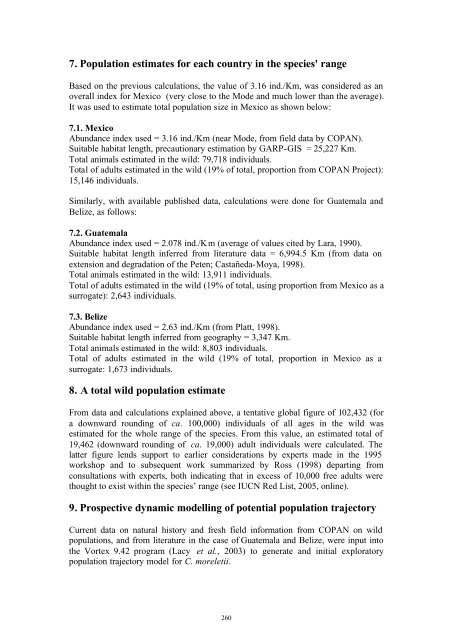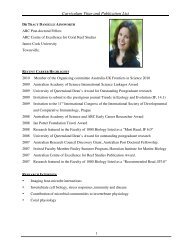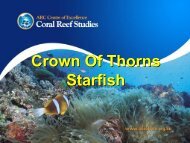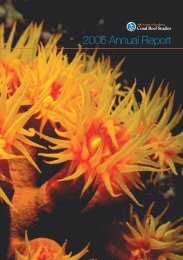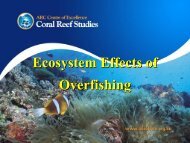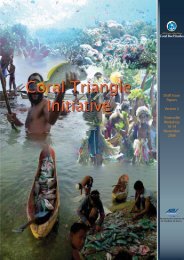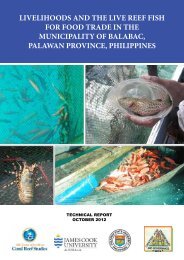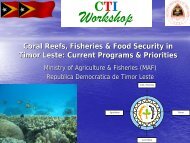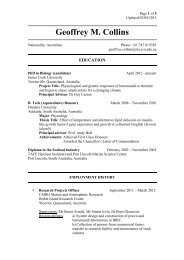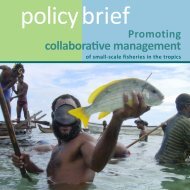Proceedings of the 18th Working Meeting of the Crocodile Specialist ...
Proceedings of the 18th Working Meeting of the Crocodile Specialist ...
Proceedings of the 18th Working Meeting of the Crocodile Specialist ...
Create successful ePaper yourself
Turn your PDF publications into a flip-book with our unique Google optimized e-Paper software.
7. Population estimates for each country in <strong>the</strong> species' range<br />
Based on <strong>the</strong> previous calculations, <strong>the</strong> value <strong>of</strong> 3.16 ind./Km, was considered as an<br />
overall index for Mexico (very close to <strong>the</strong> Mode and much lower than <strong>the</strong> average).<br />
It was used to estimate total population size in Mexico as shown below:<br />
7.1. Mexico<br />
Abundance index used = 3.16 ind./Km (near Mode, from field data by COPAN).<br />
Suitable habitat length, precautionary estimation by GARP-GIS = 25,227 Km.<br />
Total animals estimated in <strong>the</strong> wild: 79,718 individuals.<br />
Total <strong>of</strong> adults estimated in <strong>the</strong> wild (19% <strong>of</strong> total, proportion from COPAN Project):<br />
15,146 individuals.<br />
Similarly, with available published data, calculations were done for Guatemala and<br />
Belize, as follows:<br />
7.2. Guatemala<br />
Abundance index used = 2.078 ind./Km (average <strong>of</strong> values cited by Lara, 1990).<br />
Suitable habitat length inferred from literature data = 6,994.5 Km (from data on<br />
extension and degradation <strong>of</strong> <strong>the</strong> Peten; Castañeda-Moya, 1998).<br />
Total animals estimated in <strong>the</strong> wild: 13,911 individuals.<br />
Total <strong>of</strong> adults estimated in <strong>the</strong> wild (19% <strong>of</strong> total, using proportion from Mexico as a<br />
surrogate): 2,643 individuals.<br />
7.3. Belize<br />
Abundance index used = 2.63 ind./Km (from Platt, 1998).<br />
Suitable habitat length inferred from geography = 3,347 Km.<br />
Total animals estimated in <strong>the</strong> wild: 8,803 individuals.<br />
Total <strong>of</strong> adults estimated in <strong>the</strong> wild (19% <strong>of</strong> total, proportion in Mexico as a<br />
surrogate: 1,673 individuals.<br />
8. A total wild population estimate<br />
From data and calculations explained above, a tentative global figure <strong>of</strong> 102,432 (for<br />
a downward rounding <strong>of</strong> ca. 100,000) individuals <strong>of</strong> all ages in <strong>the</strong> wild was<br />
estimated for <strong>the</strong> whole range <strong>of</strong> <strong>the</strong> species. From this value, an estimated total <strong>of</strong><br />
19,462 (downward rounding <strong>of</strong> ca. 19,000) adult individuals were calculated. The<br />
latter figure lends support to earlier considerations by experts made in <strong>the</strong> 1995<br />
workshop and to subsequent work summarized by Ross (1998) departing from<br />
consultations with experts, both indicating that in excess <strong>of</strong> 10,000 free adults were<br />
thought to exist within <strong>the</strong> species’ range (see IUCN Red List, 2005, online).<br />
9. Prospective dynamic modelling <strong>of</strong> potential population trajectory<br />
Current data on natural history and fresh field information from COPAN on wild<br />
populations, and from literature in <strong>the</strong> case <strong>of</strong> Guatemala and Belize, were input into<br />
<strong>the</strong> Vortex 9.42 program (Lacy et al., 2003) to generate and initial exploratory<br />
population trajectory model for C. moreletii.<br />
260


